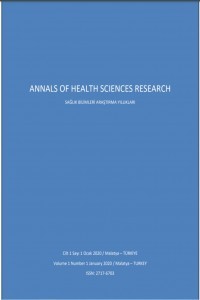Üniversite Öğrencilerinin Stresle Başa Çıkma Tarzlarının Menstrual Düzensizliğe Etkisi
Menstrual Düzensizlik, Stresle Başa Çıkma, Üniversite Öğrencileri
The Effect of Ways of Coping With Stress by University Students on Menstrual Irregularities
Cope With Stress, Irregular Menstruation, University Students,
___
- Palm-fischbacher S, Ehlert U. Dispositional resilience as a moderator of the relationship between chronic stress and irregular menstrual cycle. J Psychosom Obstet Gynaecol 2014; 35(2): 42–50.
- Özdemir F, Pasinlioğlu T. Adet düzensizliği şikayeti olan bekar adölesanların anksiyete düzeylerinin incelenmesi. Yüksekokulu Dergisi 2007; 10(1): 30-40. Üniversitesi Hemşirelik
- Cakır M, Mungan I, Karakas T., Girişken I., Okten A. Menstrual pattern and common menstrual disorders among university students in Turkey. Pediatr Int 2007; 49(6): 938–942.
- Rigon F, Sanctis V, Bernasconi S., Bianchin L., Bona G., Bozzola M., Buzi F., Radetti G., Tatò L., Tonini G., Sanctis C., Perissinotto E. Menstrual pattern and menstrual disorders among adolescents: an update of the Italian data. Ital J Pediatr 2012; Aug 14; 38: 38. doi: 10.1186/1824-7288-38-38.
- Chrzanowska D, Wdowiak L, Bojar I. The origin of stress, its causes, symptoms and frequency of appearance among the students of Medical University of Lublin. Ann Univ Mariae Curie Sklodowska Med 2004; 59(1): 438-443.
- Temel E, Bahar A, Çuhadar D. Öğrenci hemşirelerin stresle başetme tarzları ve depresyon düzeylerinin belirlenmesi. Fırat Sağlık Hizmetleri Dergisi 2007; 2(5): 107-118.
- Sood M, Azlinawati AD, Daher AM. Poor correlatıon of stress levels and menstrual patterns among medıcal students. J Asıan Behav Studies (JAS) 2012; 2(7): 59- 66.
- Ekinci M, Şahin Altun Ö, Can G. Hemşirelik öğrencilerinin stresle başa çıkma tarzları ve atılganlık düzeylerinin bazı değişkenler açısından incelenmesi. Psikiyatri Hemşireliği Dergisi 2013; 4(2): 67-74.
- Chang PJ, Chen PC, Hesıeh CJ., Chıu L. Risk factors on the menstrual cycle of healthy Taiwanese college nursing students. Aust N Z J Obstet Gynaecol 2009; 49: 689–694.
- Harlow SD, Matanoski GM. The association between weight, physical activity, and stress and variation in the length of the menstrual cycle. Am J Epidemiol 1991; 133: 38–49.
- Allsworth JE, Clarke J, Peipert JF, Hebert MR, Cooper A, Boardman LA. The influence of stress on the menstrual cycle among newly incarcerated women. Womens Health Issues 2007; 17: 202–209.
- Fenster L, Waller K, Chen J, Hubbard AE, Windham GC, Elkin E, Swan S. Psychological stress in the workplace and menstrual function. Am J Epidemiol 1999; 149: 127–134.
- Edozien LC. Mind over matter: psychological factors and the menstrual cycle. Curr Opin Obstet Gynaecol 2006; 18(4): 452-456.
- Bulut N. İlköğretim öğretmenlerinde, stres yaratan yaşam olayları ve stresle başaçıkma tarzlarının çeşitli değişkenlerle ilişkisi. Kastamonu Eğitim Dergisi 2005; 13(2): 465-478.
- Taşkın L. Üreme Siklusu Anomalileri. Doğum ve Kadın Sağlığı Hemşireliği, Sistem Ofset Matbaacılık Ankara, 2009, ss: 611-618.
- Şahin D, Durak A. Stresle Başa Çıkma Tarzları Ölçeği: Üniversite öğrencileri için uyarlanması. Psikoloji Dergisi 1995; 10(34): 56-73.
- Büyüköztürk Ş. Sosyal Bilimler İçin Veri Analizi El Kitabı. Pegem Yayıncılık, Ankara, 2007.
- Adinma ED, Adinma JI. Menstrual characteristics amongst south-eastern Nigerian adolescent school girls. West Afr J Med 2009; 28(2): 110-113.
- Motzer SA, Hertig V. Stress, stress response, and health. Nurs Clin N Am 2004; 39: 1-17.
- Romans S, Clarkson R, Einstein G, Petrovic M, Stewart D. Mood and the menstrual cycle: a review of prospective data studies. Gend Med 2012; 9(5): 361- 384.
- Davydow DM, Shapiro D, Goldstein IB. Moods in everyday situations: effects of menstrual cycle, work, and personality. J Psychosom Res 2004; 56: 27-33.
- Başlangıç: 2012
- Yayıncı: İnönü Üniversitesi
Genel Cerrahi Hastalarında Ameliyat Sonrası Konstipasyon Riski
Üniversite Öğrencilerinin Stresle Başa Çıkma Tarzlarının Menstrual Düzensizliğe Etkisi
Yeşim AKSOY DERYA, Sermin Timur TAŞHAN, Tuba UÇAR
Elastomerik Ölçü Materyalleri Dezenfeksiyonu ve Raf Ömrü
Mustafa KOCACIKLI, Betül Kökdoğan BOYACI
Oral Premalign Lezyonların Teşhis Yöntemleri
Fahrettin KALABALİK, Elif Tarım ERTAŞ
Atların Terapötik lı Kullanımı
Abdurrahman KÖSEMAN, İbrahim ŞEKER
Engelli Çocuğu Olan Ailelerin Yaşam Kalitesi
Yasir Furkan ÇAĞIN, Yüksel SEÇKİN, Emin BODAKÇİ, Mahmut ŞAHİN
Nedenleri ve Sonuçlarıyla Doğum Korkusu
Nadir Karşılaşılan Bir Endodontik Problem: Radiks Entomolaris
Cinsel İstismar Mağduru Çocuklarla Çalışan Uzmanların Gözünden Mağdur Çocukların Özellikleri
